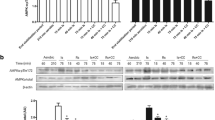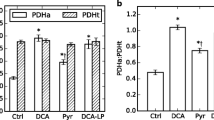Abstract
We studied the effect of exogenous adenosine in isolated perfused normoxic rat hearts on glycolytic flux through pyruvate kinase (PK). We compared its effect with that of myxothiazol, an inhibitor of mitochondrial ATP production. Moreover, we tested whether an increase of membrane ionic flux with monensin is linked to a stimulation of glycolytic flux through PK. After a 20-min stabilization period adenosine, myxothiazol or monensin were administrated to the perfusate continuously at various concentrations during 10 min. The contraction was monitored and the lactate production in coronary effluents evaluated. The amount of adenine nucleotides and phosphoenolpyruvate was measured in the frozen hearts. Myxothiazol induced a decrease of the left ventricular developed pressure (LVDP : −40%) together with a stimulation of glycolytic flux secondary to PK activation. In contrast, adenosine primarily reduced heart rate (HR: −30%) with only marginal effects on LVDP. This was associated with an inhibition of glycolysis at the level of PK. The Na+ ionophore monensin affected HR (+14%) and LVDP (+25%). This effect was associated with a stimulation of glycolysis secondary to the stimulation of PK. These results provide new information of action of adenosine in the heart and support the concept of a direct coupling between glycolysis and process regulating sarcolemmal ionic fluxes.
Similar content being viewed by others
References
Kobayashi K, Neely JR: Control of maximum rates of glycolysis in rat cardiac muscle. Circ Res 44: 166–175, 1979
Pierce GN, Philipson KD: Binding of glycolytic enzymes to cardiac sarcolemmal and sarcoplasmic reticular membranes. J Biol Chem 260: 6862–6870, 1985
Weiss J, Hiltbrand B: Functional compartmentation of glycolytic versus oxidative metabolism in isolated rabbit heart. J Clin Invest 75: 436–447, 1985
Weiss JN, Lamp ST: Cardiac ATP-sensitive K+ channels. Evidence for preferential regulation by glycolysis. J Gen Physiol 94: 911–935, 1989
Xu KY, Becker LC: Ultrastructural localization of glycolytic enzymes on sarcoplasmic reticulum vesticles. J Histochem Cytochem 46: 419–427, 1998
James JH, Wagner KR, King JK, Leffler RE, Upputuri RK, Balasubramaniam A et al.: Stimulation of both aerobic glycolysis and Na(+)-K(+)-ATPase activity in skeletal muscle by epinephrine or amylin. Am J Physiol 277: E176–186, 1999
Luchette FA, Friend LA, Brown CC, Upputuri RK, James JH: Increased skeletal muscle Na+, K+-ATPase activity as a cause of increased lactate production after hemorrhagic shock. J Trauma 44: 796–801; discussion 801–793, 1998
Lynch RM, Balaban RS: Coupling of aerobic glycolysis and Na+-K+-ATPase in renal cell line MDCK. Am J Physiol 253: C269–276, 1987
Ichai C, El-Mir MY, Nogueira V, Piquet MA, Chauvin C, Fontaine E et al.: Exogenous Mg-ATP induces a large inhibition of pyruvate kinase in intact rat hepatocytes. J Biol Chem 276: 6398–6403, 2001
Vassort G: Adenosine 5′-triphosphate: A P2-purinergic agonist in the myocardium. Physiol Rev 81: 767–806, 2001
Ely SW, Berne RM: Protective effects of adenosine in myocardial ischemia. Circulation 85: 893–904, 1992
Fraser H, Lopaschuk GD, Clanachan AS: Alteration of glycogen and glucose metabolism in ischaemic and post-ischaemic working rat hearts by adenosine A1 receptor stimulation. Br J Pharmacol 128: 197–205, 1999
Lasley RD, Rhee JW, Van Wylen DG, Mentzer RM, Jr: Adenosine A1 receptor mediated protection of the globally ischemic isolated rat heart. J Mol Cell Cardiol 22: 39–47, 1990
Shryock JC, Belardinelli L: Adenosine and adenosine receptors in the cardiovascular system: biochemistry, physiology, and pharmacology. Am J Cardiol 79: 2–10, 1997
Thornton JD, Liu GS, Olsson RA, Downey JM: Intravenous pretreatment with A1-selective adenosine analogues protects the heart against infarction. Circulation 85: 659–665, 1992
Mainwaring R, Lasley R, Rubio R, Wyatt DA, Mentzer RM, Jr: Adenosine stimulates glucose uptake in the isolated rat heart. Surgery 103: 445–449, 1988
Wyatt DA, Edmunds MC, Rubio R, Berne RM, Lasley RD, Mentzer RM, Jr: Adenosine stimulates glycolytic flux in isolated perfused rat hearts by A1-adenosine receptors. Am J Physiol 257: H1952–1957, 1989
Finegan BA, Clanachan AS, Coulson CS, Lopaschuk GD: Adenosine modification of energy substrate use in isolated hearts perfused with fatty acids. Am J Physiol 262: H1501–1507, 1992
Bergmeyer HU: Methods of Enzymatic Analysis, 2nd edn. Verlag Chemie, Academic Press, London, 1974, 1464–1468
Leong HS, Grist M, Parsons H, Wambolt RB, Lopaschuk GD, Brownsey R et al.: Accelerated rates of glycolysis in the hypertrophied heart: Are they a methodological artifact? Am J Physiol Endocrinol Metab 282: E1039–1045, 2002
Aussedat J, Ray A, Lortet S, Reutenauer H, Grably S, Rossi A: Phosphorylated compounds and function in isolated hearts: A 31P-NMR study. Am J Physiol 260: H110–117, 1991
Aussedat J: Effect of uridine supply on glycogen resynthesis after ischaemia in the isolated perfused rat heart. Cardiovasc Res 17: 145–151, 1983
Bergmeyer HU: Methods of Enzymatic Analysis, 2nd edn, Verlag Chemie, Academic Press, London, 1446–1448, 1974
Fell D: Understanding the control of metabolism, frontiers in metabolism. In: K. Snell (ed), Portland Press, London, 1997, pp 301
Yokoshiki H, Sunagawa M, Seki T, Sperelakis N: ATP-sensitive K+ channels in pancreatic, cardiac, and vascular smooth muscle cells. Am J Physiol 274: C25–37, 1998
Thorn JA, Jarvis SM: Adenosine transporters. Gen Pharmacol 27: 613–620, 1996
Tucker AL, Robeva AS, Taylor HE, Holeton D, Bockner M, Lynch KR et al.: A1 adenosine receptors. Two amino acids are responsible for species differences in ligand recognition. J Biol Chem 269: 27900–27906, 1994
Pilkis SJ, Granner DK: Molecular physiology of the regulation of hepatic gluconeogenesis and glycolysis. Annu Rev Physiol 54: 885–909, 1992
Novel-Chate V, Rey V, Chiolero R, Schneiter P, Leverve X, Jequier E et al.: Role of Na+-K+-ATPase in insulin-induced lactate release by skeletal muscle. Am J Physiol Endocrinol Metab 280: E296–300, 2001
Yamamoto K, Ikeda U, Seino Y, Tsuruya Y, Oguchi A, Okada K et al.}: Regulation of Na, K-adenosine triphosphatase gene expression by sodium ions in cultured neonatal rat cardiocytes. J Clin Invest 92: 1889–1895, 1993
James JH, Fang CH, Schrantz SJ, Hasselgren PO, Paul RJ, Fischer JE: Linkage of aerobic glycolysis to sodium-potassium transport in rat skeletal muscle. Implications for increased muscle lactate production in sepsis. J Clin Invest 98: 2388–2397, 1996
Author information
Authors and Affiliations
Corresponding author
Rights and permissions
About this article
Cite this article
Peltier, S., Burelle, Y., Novel-Chate, V. et al. Effect of exogenous adenosine and monensin on glycolytic flux in isolated perfused normoxic rat hearts: Role of pyruvate kinase. Mol Cell Biochem 277, 55–61 (2005). https://doi.org/10.1007/s11010-005-4882-2
Received:
Accepted:
Issue Date:
DOI: https://doi.org/10.1007/s11010-005-4882-2




